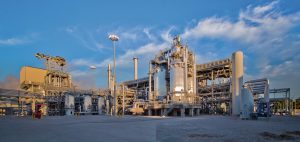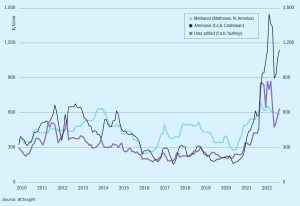
Market Outlook
The market is anticipated to correct lower throughout the rest of the first quarter. Once a clearer picture over seasonal fertilizer demand in Europe emerges, this could stabilise downward momentum.

The market is anticipated to correct lower throughout the rest of the first quarter. Once a clearer picture over seasonal fertilizer demand in Europe emerges, this could stabilise downward momentum.
Fulcrum BioEnergy says that it has successfully produced low-carbon synthetic crude oil using landfill waste as a feedstock at its Sierra BioFuels Plant, the world’s first commercial-scale landfill waste-to-fuels plant. Located outside of Reno, Nevada, Sierra will produce approximately 11 million gallons of renewable, low-carbon transportation fuels each year from approximately 175,000 t/a of landfill waste.

Air Liquide presents the results of an internal study to identify preferred natural gas-based plant configurations at a methanol capacity of 250 t/d. Delivering small capacity plants requires a focus on the total cost of ownership (TCO) for the economics to be successful, in addition to the CO 2 footprint of the operation. As found by this study, SMR concepts are naturally power balanced for standalone greenfield operations and show no particular advantage for power import in a brownfield setting. POX and ATR cases are greatly improved and even advantaged in a brownfield setting compared to SMR when shifting from power balance to power import cases.

Advanced Methanol Amsterdam (AMA) is a production facility, that will be realised in the Port of Amsterdam's Biopark, which is destined to produce advanced methanol that meets the European renewable energy directive (RED) requirements. Once completed, AMA will be the flagship production site for GIDynamics and GIDARA Energy and for its High Temperature Winkler (HTW ® ) gasification technology. AMA will also be the first of its kind green methanol unit designed by Casale.

The ammonia market appears to be oversupplied as of the end of October 2022, with a ready availability of spot cargoes. Coupled with increased availability from European producers due to an easing of gas prices, this seemed to indicate bearish market sentiment for the immediate future.
Casale has developed a range of methanol-ammonia coproduction processes to match different requirements according to product capacity.

Industry focus on technologies to reduce the carbon intensity of ammonia and methanol production has been intensifying. In this article thyssenkrupp Uhde, Proton Ventures, Toyo Engineering Corporation, Stamicarbon, BD Energy Systems and KBR report on some of their latest technology developments towards decarbonisation.

Fischer-Tropsch technology has long offered alternative production routes to synthetic fuels, but has struggled to make a use case outside of some niche applications. Could the greening of the chemical industry offer another way forward for the technology?
Maersk has ordered six more 17,000 teu (twenty-foot equivalent unit) container ships capable of running on methanol from Hyundai Heavy Industries (HHI). The order brings Maersk’s total order book of dual-fuel vessels capable of running on methanol to 19. Maersk said the new ships will replace existing tonnage in its fleet when they’re delivered in 2025. When all 19 vessels on order join the fleet and replace older tonnage, CO2 savings will be around 2.3 million t/a, according to Maersk. Maersk has committed itself to renewable methanol as a pathway to zero emissions shipping. Its first vessels are due for delivery from Q1 2024. The company has also signed several green methanol fuel supply agreements and joined a partnership to create the first e-methanol plant in Southeast Asia. Maersk is also working with Japanese trading house Mitsui and the American Bureau of Shipping (ABS), to jointly conduct a detailed feasibility study of methanol bunkering logistics in Singapore.

Maire Tecnimont subsidiary MyRechemical has been awarded a basic engineering contract for a waste to methanol and hydrogen plant to be located in Empoli, Tuscany. The scope of work includes the basic engineering design of the plant and the provision of necessary documentation to start the plant’s public authorisation process with the Tuscany region. The basic engineering phase is expected to be completed by the end of 2022. Once completed, the plant will process 256,000 t/a of non-recyclable waste and will produce 125,000 t/a of methanol and 1,400 t/a of hydrogen. The plant will use MyRechemical’s chemical conversion technology which allows the recovery of waste that cannot be mechanically recycled, or other types of unsortable dry waste. The carbon and hydrogen in the waste are converted via gasification into synthesis gas, which is used to produce low-carbon methanol and hydrogen.